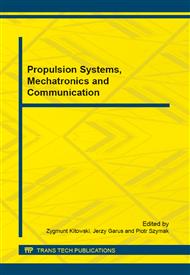[1]
R. Ciach, Concepts of changes in the German economy, Czysta Energia 11 (2013) 24–26. (in Polish).
Google Scholar
[2]
Directive 2009/28/EC of the European Parliament and of the Council of 23 April 2009 on the promotion of the use of energy from renewable sources and amending and subsequently repealing, Directives 2001/77/EC and 2003/30/EC.
DOI: 10.1017/cbo9780511664885.044
Google Scholar
[3]
W. Budzyński, S. Bielski, Energy raw materials of agricultural origin, Part I Biocomponents of liquid fuels, Acta Scientiarum Polonorum, Agricultura 3 (2004) 5–14. (in Polish).
Google Scholar
[4]
S. Kaczmarek, R. Krawczyk, The usefulness of herbicides for weed control in winter cameline, Progress in Plant Protection 47 (2007) 129–132. (in Polish).
Google Scholar
[5]
Ł. Jęczmiołek, Oil from camelina sativa (Camelina sativa) - opportunity for development of second generation biofuels, Nafta-Gaz 9 (2010) 841–848. (in Polish).
Google Scholar
[6]
Z. Mirek, Genus Camelina in Poland – Taxonomy, distribution and habitats. Fragmenta Floristica et Geobotanica, Ann. 27(1981) 445–507.
Google Scholar
[7]
A. Artyszak, Deputy of rapeseed, Farmer 23 (2006) 22–23 (in Polish).
Google Scholar
[8]
M. Tańska, D. Rotkiewicz, M. Ambrosewicz-Walacik, Effect of industrial conditions of heat treatment of rape, mustard, flax and camelina seeds on the quality of oils intended for biodiesel production, Pol. J. Natur. Sc. 28 (2013) 449–462.
Google Scholar
[9]
Czysta energia, Poland - the new center of biofuel production, Czysta Energia 11 (2013) 41. (in Polish).
Google Scholar
[10]
M. Tańska, D. Rotkiewicz, M. Ambrosewicz-Walacik, Effect of heating conditions of flax and false flax seeds on quality of oils for biodiesel, Nauka Przyr. Technol. 7 (2013) #57. (in Polish).
Google Scholar
[11]
B. Buczek, L. Czepirski, Applicability of used rapeseed oil for production of biodiesel, INFORM 15 (2004) 186–188.
Google Scholar
[12]
A.S. Ramadhas, S. Jayaraj, C. Muraleedharan, Biodiesel production from high FFA rubber seed oil, Fuel 84 (2005) 335–340.
DOI: 10.1016/j.fuel.2004.09.016
Google Scholar
[13]
R. Wojtkowiak, P. Frąckowiak, P. Kaczyński, A new method to obtain methyl esters from Camelina Sativa L. oil to feed piston compression – ignition engine, J. Res. Appl. Agric. Engng. 54 (2009) 171–178.
Google Scholar
[14]
Polish Standard PN-EN ISO 662: 2001. Oils and Animal and vegetable fats. Determination of moisture content and volatile substances. PKN, Warszawa. (in Polish).
Google Scholar
[15]
Polish Standard PN-ISO 660: 2005. Oils and Animal and vegetable fats. Determination of acid value and acidity. PKN, Warszawa. (in Polish).
Google Scholar
[16]
Polish Standard PN-EN ISO 5508: 1996. Analysis of fatty acid methyl esters by gas chromatography. PKN, Warszawa. (in Polish).
Google Scholar
[17]
Polish Standard PN-EN ISO 3104: 2004. Petroleum products. Transparent and opaque liquids. Determination of kinematic viscosity and calculation of dynamic viscosity. PKN, Warszawa. (in Polish).
DOI: 10.3403/30366326
Google Scholar
[18]
Polish Standard PN-EN ISO 3675: 2004. Petroleum and liquid petroleum products. Laboratory determination of density. Method with hydrometer. PKN, Warszawa. (in Polish).
DOI: 10.3403/01617004
Google Scholar
[19]
Polish Standard PN-EN 14104: 2004. Products of processing oils and fats. Fatty acid methyl esters (FAME). Determination of the acid number. PKN, Warszawa.
Google Scholar
[20]
Polish Standard PN-EN 12662: 2009. Liquid petroleum products. Determination of contamination in middle distillates. PKN, Warszawa. (in Polish).
Google Scholar
[21]
Polish Standard PN-EN ISO 20884: 2012. Petroleum products. Determination of sulfur content of fuels for motor vehicles, X-ray fluorescence spectrometry wavelength-dispersive. PKN, Warszawa. (in Polish).
DOI: 10.3403/30205359
Google Scholar
[22]
Polish Standard PN-EN ISO 3679: 2007. Determination of flash point. Fast, equilibrium in closed crucible. PKN, Warszawa. (in Polish).
Google Scholar
[23]
Polish Standard PN-EN 116: 2001. Diesel fuels and fuel oils light. Determination of the cold filter blocking. PKN, Warszawa. (in Polish).
Google Scholar
[24]
Polish Standard PN-EN 14112: 2004. Products of processing oils and fats. Fatty acid methyl esters (FAME). Determination of oxidation stability (accelerated oxidation test). PKN, Warszawa. (in Polish).
DOI: 10.3403/02807000u
Google Scholar
[25]
Polish Standard PN-EN 14214: 2012. Automotive fuels. Fatty acid methyl esters (FAME) to compression-ignition (diesel) engines. Requirements and test methods. PKN, Warszawa. (in Polish).
DOI: 10.3403/30176475
Google Scholar
[26]
Polish Standard PN-EN 590: 2009. Automotive fuels. Diesel fuels. Requirements and test methods. PKN, Warszawa. (in Polish).
Google Scholar
[27]
S. Lebedevas, G. Lebedeva, V. Makarevičiene, I. Kazanceva, K. Kazancev, Analysis of the ecological parameters of the diesel engine powered with biodiesel fuel containing methyl esters from Camelina sativa oil, Transport 25 (2010) 22–28.
DOI: 10.3846/transport.2010.04
Google Scholar
[28]
P. Orliński, The effect of diesel fuel mixture and camelina oil ester on selected parameters of combustion process, Journal of KONES 20 (2013) 291–298.
DOI: 10.5604/12314005.1136171
Google Scholar
[29]
B.R. Moser, S.F. Vaughn, Evaluation of alkyl esters from camelina sativa oil as biodiesel and as blend components in ultra low-sulfur diesel fuel. Bioresource Technol. 101 (2010) 646–653.
DOI: 10.1016/j.biortech.2009.08.054
Google Scholar
[30]
E. Skrzyńska, A. Wilk, Comparison of the properties of the esters derived from lower alcohols and rapeseed oil, Czasopismo Techniczne Technical Transaction 10 (2011) 253–267. (in Polish).
Google Scholar
[31]
N.U. Soriano, A. Narani, Evaluation of biodiesel derived from Camelina sativa oil, J. Am. Oil Chem. Soc. 89 (2012) 917–923.
DOI: 10.1007/s11746-011-1970-1
Google Scholar
[32]
M.J. Ramos, C.M. Fernández, A. Casas, L. Rodríguez, Á. Pérez, Influence of fatty acid composition of raw materials on biodiesel properties, Bioresource Technol. 100 (2009) 261–268.
DOI: 10.1016/j.biortech.2008.06.039
Google Scholar


